Meet The Bigfooters
Posted by: Loren Coleman on October 16th, 2012
Here’s a bit of pondering in today’s flashback to some thoughts from April 2007, with some 2010 & 2012 updates:
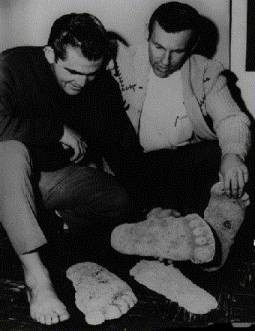
Bob Gimlin and Roger Patterson, fieldworkers first, then Patterson an author second, here, look at Bigfoot casts.
Sometimes I do drift into trying to understand the “people” part of the Bigfoot quest.
In my Bigfoot! The True Story of Apes in America (2003), I wrote Chapter 15, “The Bigfooters” to detail my thoughts on the matter of the why and the what of the searchers. I added historical and people-specific notes to this matter in my more casual analysis of the folks “looking” for Bigfoot in The Field Guide of Bigfoot and Other Mystery Primates (1999; 2006), with Patrick Huyghe, and in Tom Slick: True Life Encounters in Cryptozoology (1989; 2002).
In Bigfoot!, I decided to continue with a delineation of the differences and similarities in the various types of people involved in the research and search, which has been noted by the late Grover Krantz and John Green. I did this so the general public would stop thinking there is just one kind of “seeker” out there.
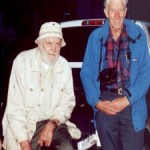
Grover Krantz, Ph. D. and John Green, academic and chronicler, defined a generation.
Frankly, although I didn’t write much then about this point, I think one of the large public misconceptions is a single type. Reinforced by the media, the thought is that the majority of seekers are of “one kind” of individual out there looking for Bigfoot – an amateur who has little or no training in science but is driven by passion and obsession to find the forest giants. Definitely the movies strengthened this myth, as demonstrated by the various “Bigfoot hunters” in Harry and the Hendersons.
In terms of field investigators, yes, most are what I lightheartedly and with all due respect call “weekend warriors.” These are mostly guys (males do dominate the field) who get their gear together (from nightscope vision to plaster of Paris) for what they consider serious searching from two days to two weeks. A few of these are outright jokers who only take a sleeping bag and beer, and say they are “Bigfoot hunting.” Thus, the newspapers love to have fun with “six-pack Joe” quotes from those kind of “Bigfooters.” Some of these “weekend warriors” are in local clubs who feel they will make a discovery which will assist the “search.”
Whether any of these people have any short-term or long-term impact is doubtful. There may be accidental discoveries by these folks of footprints or sightings, but will these people collect the material in a matter that will be acknowledged and recognized by science, by the zoologists and anthropologists who will “judge” the evidence? Will it be useful for pushing forward our knowledge of Bigfoot? Or will it end up in a pile of blobsquatch photos, shaky plaster casts, and dubious ear-witness evidence?

Jeff Meldrum, Ph. D., was handed the baton for academic Bigfootery, even before Krantz passed away, due to his frequent television appearances.
Certainly, for the real researchers and the more scientifically-based regional Bigfoot groups, lack of funding may be a factor, but context is another problem. How many of these group members are extending their passion without any grounding in zoology, anthropology, background research, or techniques in woodcraft? How many are able to acknowledge that Bigfoot ecotourism is foremost a social activity?
Ray Crowe was one of the first people whom I recall being totally honest with me that the Bigfoot groups serve the purpose as a new form of social interaction.
Indeed, if Bigfoot people would acknowledge the social and ecotourism dimensions of Bigfoot searching, the coming explosion in interest, funding, and potential to use this to the advantage of science could be more openly realized.

Rene Dahinden was the fieldworker the camera loved.
In a whole other collection of “Bigfooters,” there does appear to be more and more who are academically-oriented, but that does not mean they have more time for field investigations. This is not a criticism, but the pseudo-attempts to act as if they are field investigators by the media should probably end. There is nothing wrong with being an academic. Some filmmakers, nevertheless, stage the “professors” to show up in documentaries as if they spend their lives in the bush. They have a place in their labs and offices, doing the analysis, and there’s nothing wrong with that role.

John Bindernagel, Ph. D. brought more recognition to Jane Goodall’s pro-Bigfoot statements.

As far as I know, in a very Jane Goodall-like fashion, only Debbie Martyr (shown below) in Sumatra (in search of the Orang Pendek) has spent the last two decades directly in the jungle for most of her time out there. She continues to be one of the unsung heroes of the field – and no “weekend warrior” or “academic” will dethrone her.

The general public often forget the simple facts and history of animal collecting. Most new animals are found by local peoples, who serve as scouts and animal collectors for those that venture less frequently into the jungles and wild areas. Gone are the days of Victorian funding by zoos and museums to find new species. Most straightforward funding for cryptozoology is via documentary films and reality television programming today. That is a truth that few wish to confront. Smaller sources of cryptozoology funding come from writing.
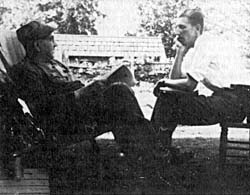

(1) John Green (right) interviews Albert Ostman; and (2) Rene Dahinden (right) interviews Ostman about Ostman’s 1924 Sasquatch abduction incident in British Columbia.
Meanwhile, some “Bigfooters” are “chroniclers,” those that write the books, articles, and today, the blogs, to keep the information flowing. It has something to do with a combination of background and age, I think. Some people start out doing fieldwork, and move into more chronicling. On the part of John Green, it was the reverse. He was a journalist who got interested in examining Sasquatch evidence in the field, secondary to his writing.
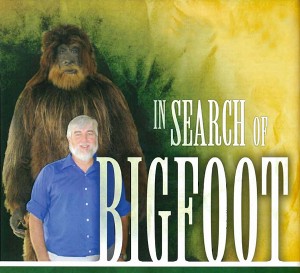
For myself, with a budding Yeti and Bigfoot interest long ago, and seeing that funding was always going to be low, I stayed in full-time social science and university research and teaching positions from 1967 until 1996, to support my cryptozoology research. Also, I decided since I lived in the USA, I should concentrate on North America. So, since 1960, I traveled to 49 states (not Alaska yet), to investigate sites, sightings, and situations regarding Sasquatch and Bigfoot. Naturally, slowly I became a more prolific writer as I was doing the field investigations, and thus I find myself today labeled a “chronicler” of such matters. But for me, of course, it felt like it was something I slowly drifted into, from fieldwork into writing (even though I did start writing in 1967). More authoring of books in the last decade seemed logical for me after I left the university sphere following my rock-climbing accident. The founding of the museum ten years ago to share, and appearing on television frequently were merely an educational extension of my “chronicling” and “fieldwork,” so to speak.
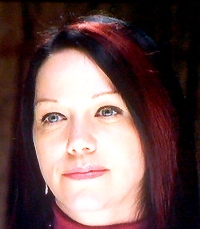
Anna Nekaris, Ph. d.
Besides gender diversity coming into the field, what other trends are occurring?

Anna-Marie Goddard, television personality.
A few good men and women are doing “cryptozoology,” and struggle to do it. But there is a darker side too, which has impacted the search in North America and, for example, in Malaysia.
There is a growing subculture of fake “Bigfooters” who want people to fund their “search” and what I think are their alleged scams. The most obvious are those who often get run out of town after people learn a little about them, but who are infrequently trying to sell people “views” of captured Bigfoot that never turn up and/or “memberships” in “expeditions” to the “subscribers.” The “expeditions” are nothing more than a day or two out in the local wooded lots or even well-known camping areas, but the general participants get to think they’ve been on a Bigfoot trek.
It is a shame and perhaps worse, but it really is a minority situation.
Actually, the variety of fringe people who get more publicity than the mainstream Bigfooters is quite vast. There’s the “Bigfoot contactees,” “pranksters,” “debunkers,” “paranormal seekers,” and “skeptics,” who all may call themselves “Bigfooters,” at one time or another. The press is more than happy to interview any of this vocal minority about the “real” state of Bigfoot affairs. But back to the darkside for a moment…those who seem to have the most dangerous influence with the media.
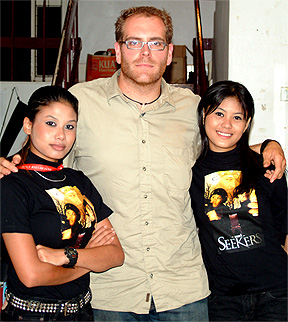
Josh Gates visited Malaysia in the midst of the “Johor Hominid” events, but was not involved in the actual hoaxing or discovering it. Instead, he is an example of how the media add programming without any insights to the investigations.
In Malaysia, I’m not sure what some of the people there were exactly thinking and doing – except at a distance – but the 2006-2007 episodes to “discover” a ‘hominid,” via what turned out to be hoaxed evidence, was a terrible set-back to Malaysia’s actual unknown hairy hominoid (perhaps even True Giant) research. Those events wiped away much of the feeling that “Bigfoot” was in Malaysia in the public’s eye, even though I understand there is a good basis of data that goes back historically for hairy hominoids in the jungles in South Asia. The folklore, reality, and good cases from treks of Harold Stephens in the 1970s to the locals’ 2004-2007 sightings are in danger of being forgotten due to the shady events that recently muddled the waters.
In a parallel of what happens in America, there’s a feud going on in Malaysia between the API and SPI, the Charles Goh camp vs the Ang-Chow camp. Some of this appears to have an ethnic undertone to it but, more importantly, this fight is not allowing the public to see through the trees to look clearly at the evidence that is a good foundation for the Malaysian Orang Dalam, Bigfoot, or whatever you want to call them. That’s the downside of having humans involved in any search for Bigfoot. Unfortunately we act so “human,” after a time, in the search and things get bogged down in personalities.
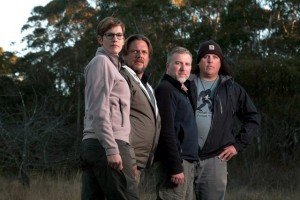
With the popularity of Animal Planet’s Finding Bigfoot and other programs, now we are entering an era of copycat “seeking Sasquatch” programming and people. Weekend cryptotourism is being developed and Bigfoot “hunts” are being planned and cryptotourists are paying for them. Reports of people staying in the woods, throwing rocks at campers and making hooting sounds, are starting to drift out of some of these “treks.”
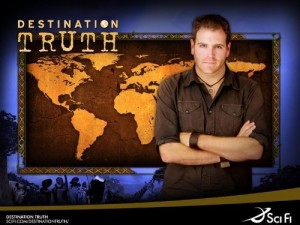
It will be interesting to see what tomorrow brings.
The upside is that most Bigfooters are decent people pursuing a mystery that we all are trying to solve together. Most Bigfooters, from “weekend warriors,” to “academics,” to “chroniclers,” are great people to know and are sincere in their quests, despite how they are portrayed in the press.
About Loren Coleman
Loren Coleman is one of the world’s leading cryptozoologists, some say “the” leading living cryptozoologist. Certainly, he is acknowledged as the current living American researcher and writer who has most popularized cryptozoology in the late 20th and early 21st centuries.
Starting his fieldwork and investigations in 1960, after traveling and trekking extensively in pursuit of cryptozoological mysteries, Coleman began writing to share his experiences in 1969. An honorary member of Ivan T. Sanderson’s Society for the Investigation of the Unexplained in the 1970s, Coleman has been bestowed with similar honorary memberships of the North Idaho College Cryptozoology Club in 1983, and in subsequent years, that of the British Columbia Scientific Cryptozoology Club, CryptoSafari International, and other international organizations. He was also a Life Member and Benefactor of the International Society of Cryptozoology (now-defunct).
Loren Coleman’s daily blog, as a member of the Cryptomundo Team, served as an ongoing avenue of communication for the ever-growing body of cryptozoo news from 2005 through 2013. He returned as an infrequent contributor beginning Halloween week of 2015.
Coleman is the founder in 2003, and current director of the International Cryptozoology Museum in Portland, Maine.










It is a vicious cycle so to speak. Cryptozoology does not command the interest for the groups that have money (Except maybe in the rare exceptions individuals are willing to pony up dollars for field research), except as you said in documentary TV which does seem to have a niche…probably with the initial success of things like In Search Of.
So, then people with an interest in cryptozoology really have to depend on themselves for the financial backing for expeditions. This is made harder by the fact that most people have to hold down a full time job (because you can’t get funding for such things). Also, where you live limits the ability to hunt cryptids…if you say, oh I don’t know, live in Iowa, just to throw out a random place, hunting cryptids is limited to hunting BF, the Beast of Bray Road, maybe a mothman sighting, and UFO’s. Unless you have the cash to world hop or go places.
I think there are a fair amount of passionate people out there who are interested in this field, but they’re limited as to how much time and resources they can commit because of their circumstances. AND, while I don’t think going camping, drinking beer til all hours and calling it a BF expedition is the best way to approach it, as we’ve seen evidence has come in from a variety of sources from an array of people from all different social and economic groups.
There is more scientific interest and more people putting their education and practical skills to the cryptids, but it is limited to those who have that passion.
However, weirder things are possible than a group of drunken college students going out for a weekend bash and accidentally stumbling upon a BF carcass…Wait, or was that already a Sci-Fi channel movie?
I think springheeledjack covered the subject pretty well. Unless you do have the money, or know someone who is willing to finance you, you are pretty well limited to what is available within a few hundred mile circle of where you live. If, by chance, you are a hunter, nature photographer or both, who does make an annual trip for indulging your interest it does make it possible to get outside your regular area but even then you will be limited because your primary interest is hunting or photography, cryptid searches are secondary.
Now if you happen to have some friends who just happen to share your interests there is always the possibility of also combining a hunting/photography trip with some fairly serious cryptid hunting.
hello, i am new to this site, i want to tell what i know about these yowies. i don’t want to hurt anybody by saying too much.
i suppose i can check comments by email, and follow through gently.
we have them here in australia, i can say in southeastern nsw, but one day i will tell you how precisely they can never be caught and how it is possible to view them.
in the similar sense i can say these mythological creatures did exist. i also know there are no ufo’s out there, only us on this planet.
i am in a predicament nobody like to hear, but i don’t have to say or prove anything, even though i get bored and continue to dig my own grave. never mind. soon it will be world news but as i say and i have to say also for ‘that being’ hiding these secrets don’t stop at nothing, while when it come’s about in world news they will know how to tell you… so let me see if anyone knows what i am insinuating here before that being might do something terrible to us again.
ah! so long and thanks for all the fish
Loren, I think you have the basis for a new book in this and other posts. It might even go mainstream and sell well on that level, if you examine the social context and worldviews of cryptid-hunters.
The whole social tourism aspect of cryptozoology has a parallel in the ghost-hunting world. You also get the people who buy all the technology and get into it for a while, or go out on a lark to a graveyard. There is probably even some crossover. I know I have been interested in Bigfoot, UFOs, and ghosts since I was a kid.
My own beliefs have evolved with my worldviews. When I was a kid, I believed in all of it (my “Legend of Boggy Creek” period). Then when I was a teen and into my young adulthood, I learned more from my Native American views of Bigfoot as a spirit, on the one hand, and the Fortean-Keelian world on the other. “Goblin Universe” and your own books that not only included Bigfoot but also Clowns, Gassers, MIB, etc. When I went to University and majored in Anthropology in my twenties, I had a physical anthropology teacher Charlene Smith in the 1980s who believed in the biological reality of Bigfoot, and I also heard stories from other Native students, and then through cultural anthropology learned more about folklore and phenomenology.
Finally, I came across the shunka warak’in info in my graduate work, and then the mounted “ringdocus” mystery began. You and I corresponded (I was thrilled to be emailing with the guy who wrote all those books I read), my info was included in your Cryptozoology book. The internet took off back around then (mid-90s) and soon I found mentions of the shunka warak’in all over the Internet. It had become part of the ouevre of cryptozoology. Soon it was conflated with all kinds of other reports. Culture and urban legends in the making (which I am sure you have seen yourself many, many times over the last few decades).
At last the mount resurfaced in the museum in Ennis and I got a look at it. From my time in natural history museums, in the woods, owning dogs and coyotes (2 coyotes) and being around wolves in zoos, I knew this animal as something different. Alas, they refused to let me take a tuft of hair for DNA analysis.
Due to all these different experiences and paradigm shifts, I realized that cryptozoology has multiple meanings for many people. And I still enjoy the hell out of it all!
I wasn’t sure how much of substance I’d find here, but I’m glad I looked.
The central misconception about squatchery is that “we’ve been looking” for fifty years, when the amount of serious looking that’s been done doesn’t amount to more than a few months or so of serious fieldwork. And that’s scattered all over the place, not concentrated at all in the way that scientists concentrate effort (and – key word – funding) when they expect discovery.
Another apparent misconception is that there is “no physical evidence.” Well, a theme that I find running like wildfire through the field is mishandled evidence. Either he never even touches it (and wishes he had later, when he knows better); or his girlfriend makes him toss it; or he and his buddy look at each other, wonder which one is gonna say the other one is crazy, and they sort of mutually agree to toss it; or it just kinda gets tossed in an am-I-crazy moment; or he gets frustrated and tosses it; or the lab goes are you kidding me here? And tosses it. Serious, grounded scientists NEVER toss ANYTHING until they know what it is. Unless, of course, they have been carefully schooled by their peers and the society at large *not* to take this particular evidence seriously. Or else…
The problem with squatchery is not the amateurishness of the amateurs so much as it is the amateurishness of the PROFESSIONALS. As I have said here times beyond my counting: scientists forget what they are when certain topics are under discussion. Scientists cannot afford – in fact, science flat forbids – two things: cynicism and close-mindedness. ON ANY TOPIC. The advancement of civilization flat depends on this. Yet scientists, being human, engage in both pretty much constantly. What the scoftics fail continually to understand is that science and scientists are mutually exclusive. The former is a virtually perfect discipline. The latter, and sometimes unfortunately, is who practices it.
There was only one way for science to react to the Patterson-Gimlin film: This is interesting. One thing we can’t do is discourage anyone – ANYONE – who wants to know what that is. Unfortunately, science doesn’t encourage or discourage. That is left up to scientists. Who fail to live up to science more often than any of us want to think about.
Neither science nor scientists have failed at all in this instance. BFers continually fail, however, by mistaking “evidence” for “proof.”
Proriter: um, you just noted the SCOFTICS’ mistake: confusing evidence and proof.
Looking firmly in the other direction from the mountain of evidence, the scoftics go: where’s the evidence? They mean: where’s the proof? They think of course that the words are synonyms. They make the further mistake of misunderstanding the difference between personal proof and scientific fact. If you have seen a sasquatch, you know science is wrong, just like when you see a zebra, you know science is right. But your proof doesn’t have to satisfy science. THEY need to have it proven to their satisfaction. That hasn’t happened, yet.
Science is responsible for proof in our society. Period. The proponents are responsible for one thing: providing the evidence for science’s review. They indeed have laid the evidence in front of science, which has not even looked at it. (A few intrepid scientists have. The mainstream, however, has ignored it.)
Refusing to even look at evidence that possesses the only two things that should be needed to compel scientific interest – frequency and coherence?
Sounds like failure to me. That’s how history will record it, trust me there.
If the sasquatch is eventually proven real, of course. That’s gotta happen first, Science. 😉
It’s strange the way sasquatch seems to divide people more than any other cryptid. While Pyle’s “Where Bigfoot Walks” covered some of this territory, there seems to be as much mystery about Bigfooters as there is about Bigfoot. Maybe it’s just because, since the phenomenon’s focus includes the relatively affluent and populous nation of the USA, there are just more people with interest and opportunity to get involved, and large numbers of people involved means some will inevitably clash. Or maybe it’s because sasquatch, more than any other zoological mystery, brings to mind the idea so many people have that there must be a purer, simpler existence out there somewhere, although we may have no real idea of how to approach it. Maybe it’s the elusiveness of the thing. Science demands exactly the same evidence for sasquatch it does for a new lizard or beetle, no more, no less, and even the most dedicated researchers can’t come up with it. We know there’s a lot of wilderness left on this continent, and a smart, wary animal could elude people a long time, but when every deer, bear, and rodent has been described, the puzzle of sasqautch makes people mentally throw up their hands. (The last North American mammals were an Alaskan shrew species and a Florida rat subspecies, both described decades ago.) Some people are attracted no doubt by the sheer enjoyment of the idea that “perfessors” all over the country would have egg on their faces if our big furry friend turns up. (The vertebrate zoology and paleontology conferences would have blood running in the halls.) And some people are attracted by the simple determination to prove that they are right about what they or others have seen.
Okay, that’s a lot of rambling (especially for a guy with no real field experience: I fall into the ‘chronicler’ category). Sasquatch would be easily the biggest discovery of the past century, bigger than Vu Quang, the biggest thing since the last big African mammals were hauled into the sunlight before WWI. I hope he’s out there, I salute the dedicated searchers, and I hope someone finds him. Until then, I can’t help picturing sasquatch watching with puzzlement and maybe even amusement as people make such a fuss over him.
My basic take on this matter is that there is a difference between cryptozoologist and monster hunter.
Cryptozoology should ideally be based in science and adhere to its methodologies. Ideally, they have scientific backgrounds or at least a good understanding of how science works. Cryptozoologists are critical and examine the evidence from all angles. They understand natural history and basic tenets of biology and zoology. They are careful with evidence and their analysis of it. They are prepared to concede to mundane explanations if that is indeed where the evidence leads. Cryptozoologists do not “believe,” but are rather driven to come to an honest and scientific understanding of the truth.
Monster hunters on the other hand are as Loren put it, primarily driven by passion and enthusiasm.
They may not have an understanding of science or its principles. There may be a biased or unscientific approach to some evidence. For instance, every strange sound or piece of footage is the creature and all hypothesizing takes that as a given. There may be cherry picking of data to favor the unknown explanation or efforts to push evidence into that direction without fully approaching all possibilities.
In this sense, I feel monster hunters as I have defined them here are more likely to lean towards “belief” or faith based hypotheses. This may not always be intentional, but rather derived from a lack of understanding of scientific approaches.
The methodology or conclusions of monster hunters will often have holes in them. There may be an unwillingness to put up evidence for peer review or to accept that a particular piece of evidence is not as strong as they think it is.
Monster hunting is more likely to be associated with sensationalism, ratings, or a desire to profit off of mystery rather than an earnest willingness to find the truth.
I think the problem is that many people and the media confuse the distinction between these two. They tend to view cryptozoology as monster hunting, and I think there is in fact a big difference.
mystery_man: Exactly.
Monster hunters tend to take givens pulled from thin air and make them the basis for their quest, rather than reviewing the evidence and drawing the takeoff points from that.
Monster hunters say “no one ever sees them because…” in direct contravention of evidence that suggests that many people, in fact, are.
Monster hunters say that “they leave no evidence,” in direct contravention of evidence that says they leave much the same kind of sign as other animals.
Or, monster hunters make claims based on no evidence whatever. and consider outlying individual reports to have all the weight of voluminous reports seeming to point to a consistent source.
The public has seen so much of this – and is generally so unschooled in how science works – that they swallow whole the supposition that there’s no fire where all the smoke is coming from.